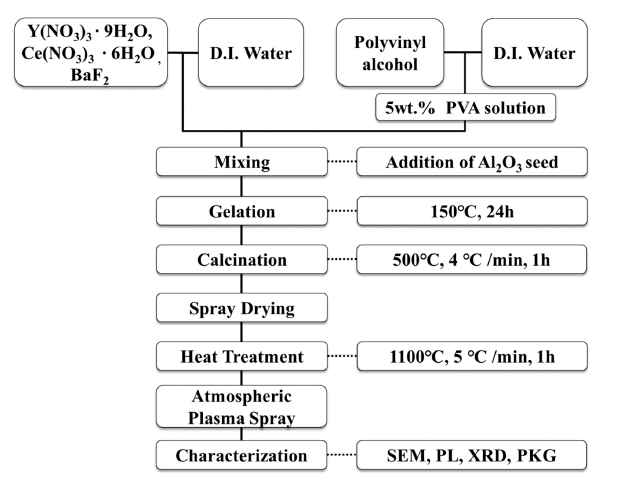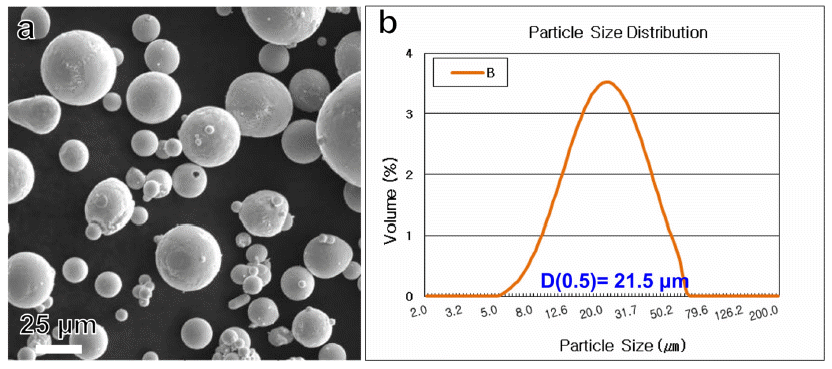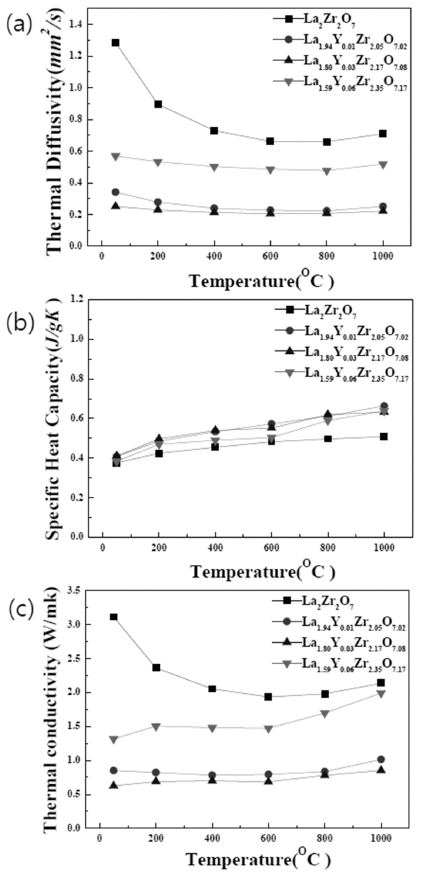Search
- Page Path
- HOME > Search
- [Korean]
- Optical Properties of Spherical YAG:Ce3+ Phosphor Powders Synthesized by Atmospheric Plasma Spraying Method Appling PVA Solution Route and Domestic Aluminium Oxide Seed
- Yong-Hyeon Kim, Sang-Jin Lee
- J Powder Mater. 2023;30(5):424-430. Published online October 1, 2023
- DOI: https://doi.org/10.4150/KPMI.2023.30.5.424

- 667 View
- 3 Download
-
 Abstract
Abstract
 PDF
PDF YAG phosphor powders were fabricated by the atmospheric plasma spraying method with the spray-dried spherical YAG precursor. The YAG precursor slurry for the spray drying process was prepared by the PVA solution chemical processing utilizing a domestic easy-sintered aluminum oxide (Al2O3) powder as a seed. The homogenous and viscous slurry resulted in dense granules, not hollow or porous particles. The synthesized phosphor powders demonstrated a stable YAG phase, and excellent fluorescence properties of approximately 115% compared with commercial YAG:Ce3+ powder. The microstructure of the phosphor powder had a perfect spherical shape and an average particle s ize of a pprox imately 30 μm. As a r esult of t he PKG t est of t he YAG p hosphor p owder, t he s ynthesized phosphor powders exhibited an outstanding luminous intensity, and a peak wavelength was observed at 531 nm.
- [Korean]
- Effect of Spray Angle the on Microstructure and Mechanical Properties of Y2O3 Coating Layer Manufactured by Atmospheric Plasma Spray Process
- Yu-Jin Hwang, Kyoung-Wook Kim, Ho-Young Lee, Sik-Chol Kwon, Kee Ahn Lee
- J Korean Powder Metall Inst. 2021;28(4):310-316. Published online August 1, 2021
- DOI: https://doi.org/10.4150/KPMI.2021.28.4.310

- 1,194 View
- 29 Download
- 5 Citations
-
 Abstract
Abstract
 PDF
PDF The effects of different spray angles (90°, 85°, 80°) on the microstructure and mechanical properties of a Y2O3 coating layer prepared using the atmospheric plasma spray (APS) process were studied. The powders employed in this study had a spherical shape and included a cubic Y2O3 phase. The APS coating layer exhibited the same phase as the powders. Thickness values of the coating layers were 90°: 203.7 ± 8.5 μm, 85°: 196.4 ± 9.6 μm, and 80°: 208.8 ± 10.2 μm, and it was confirmed that the effect of the spray angle on the thickness was insignificant. The porosities were measured as 90°: 3.9 ± 0.85%, 85°: 11.4 ± 2.3%, and 80°: 12.7 ± 0.5%, and the surface roughness values were 90°: 5.9 ± 0.3 μm, 85°: 8.5 ± 1.1 μm, and 80°: 8.5 ± 0.4 μm. As the spray angle decreased, the porosity increased, but the surface roughness did not show a significant difference. Vickers hardness measurements revealed values of 90°: 369.2 ± 22.3, 85°: 315.8 ± 31.4, and 80°: 267.1 ± 45.1 HV. It was found that under the condition of a 90° angle with the lowest porosity exhibited the best hardness value. Based on the aforementioned results, an improved method for the APS Y2O3 coating layer was also discussed.
-
Citations
Citations to this article as recorded by- The Effect of In Situ Laser-Assisted Plasma Spraying on the Plasma Etching Resistance of Yttrium Oxide Coating
Xutao Zhao, Tian Xie, Panpan Zhang, Zhehe Yao, Qunli Zhang, Jiake Deng, Yongfeng Sui, Jianhua Yao
Coatings.2024; 14(11): 1427. CrossRef - Investigation of contamination particles generation and surface chemical reactions on Al2O3, Y2O3, and YF3 coatings in F-based plasma
Jongho So, Minjoong Kim, Hyuksung Kwon, Seonjeong Maeng, Eunmi Choi, Chin-Wook Chung, Ju-Young Yun
Applied Surface Science.2023; 629: 157367. CrossRef - Cleaning Effect of Atmospheric-Plasma-Sprayed Y2O3 Coating Using Piranha Solution Based on Contamination Particle Measurement
Hyuksung Kwon, Minjoong Kim, Jongho So, Seonjeong Maeng, Jae-Soo Shin, Ju-Young Yun
Coatings.2023; 13(3): 653. CrossRef - The effect of powder particle size on the corrosion behavior of atmospheric plasma spray-Y2O3 coating: Unraveling the corrosion mechanism by fluorine-based plasma
Minjoong Kim, Eunmi Choi, Dongjin Lee, Jungpil Seo, Tae-Sun Back, Jongho So, Ju-Young Yun, Song-Moon Suh
Applied Surface Science.2022; 606: 154958. CrossRef - The Effect of Powder Particle Size on the Corrosion Behavior of Atmospheric Plasma Spray-Y2o3 Coating: Unraveling the Corrosion Mechanism by Fluorine-Based Plasma
Minjoong Kim, Eunmi Choi, Dongjin Lee, Jungpil Seo, Tae Sun Back, Jongho So, Ju-Young Yun, Song-Moon Suh
SSRN Electronic Journal .2022;[Epub] CrossRef
- The Effect of In Situ Laser-Assisted Plasma Spraying on the Plasma Etching Resistance of Yttrium Oxide Coating
- [Korean]
- Fabrication, Microstructure and Adhesive Properties of BCuP-5 Filler Metal/Ag Plate Composite by using Plasma Spray Process
- Seong-June Youn, Young-Kyun Kim, Jae-Sung Park, Joo-Hyun Park, Kee-Ahn Lee
- J Korean Powder Metall Inst. 2020;27(4):333-338. Published online August 1, 2020
- DOI: https://doi.org/10.4150/KPMI.2020.27.4.333

- 569 View
- 3 Download
-
 Abstract
Abstract
 PDF
PDF In this study, we fabricate a thin- and dense-BCuP-5 coating layer, one of the switching device multilayers, through a plasma spray process. In addition, the microstructure and macroscopic properties of the coating layer, such as hardness and bond strength, are investigated. Both the initial powder feedstock and plasma-sprayed BCuP-5 coating layer show the main Cu phase, Cu-Ag-Cu3P ternary phases, and Ag phase. This means that microstructural degradation does not occur during plasma spraying. The Vickers hardness of the coating layer was measured as 117.0 HV, indicating that the fine distribution of the three phases enables the excellent mechanical properties of the plasma-sprayed BCuP-5 coating layer. The pull-off strength of the plasma-sprayed BCuP-5 coating layer is measured as 16.5 kg/cm2. Based on the above findings, the applicability of plasma spray for the fabrication process of low-cost multi-layered electronic contact materials is discussed and suggested.
- [Korean]
- Effect of Deposition Parameter and Mixing Process of Raw Materials on the Phase and Structure of Ytterbium Silicate Environmental Barrier Coatings by Suspension Plasma Spray Method
- Ho-lim Ryu, Seon-A Choi, Sung-Min Lee, Yoon-Soo Han, Kyun Choi, Sahn Nahm, Yoon-Suk Oh
- J Korean Powder Metall Inst. 2017;24(6):437-443. Published online December 1, 2017
- DOI: https://doi.org/10.4150/KPMI.2017.24.6.437

- 657 View
- 3 Download
- 1 Citations
-
 Abstract
Abstract
 PDF
PDF SiC-based composite materials with light weight, high durability, and high-temperature stability have been actively studied for use in aerospace and defense applications. Moreover, environmental barrier coating (EBC) technologies using oxide-based ceramic materials have been studied to prevent chemical deterioration at a high temperature of 1300°C or higher. In this study, an ytterbium silicate material, which has recently been actively studied as an environmental barrier coating because of its high-temperature chemical stability, is fabricated on a sintered SiC substrate. Yb2O3 and SiO2 are used as the raw starting materials to form ytterbium disilicate (Yb2Si2O7). Suspension plasma spraying is applied as the coating method. The effect of the mixing method on the particle size and distribution, which affect the coating formation behavior, is investigated using a scanning electron microscope (SEM), an energy dispersive spectrometer (EDS), and X-ray diffraction (XRD) analysis. It is found that the originally designed compounds are not effectively formed because of the refinement and vaporization of the raw material particles, i.e., SiO2, and the formation of a porous coating structure. By changing the coating parameters such as the deposition distance, it is found that a denser coating structure can be formed at a closer deposition distance.
-
Citations
Citations to this article as recorded by- Fabrication, Microstructure and Adhesive Properties of BCuP-5 Filler Metal/Ag Plate Composite by using Plasma Spray Process
Seong-June Youn, Young-Kyun Kim, Jae-Sung Park, Joo-Hyun Park, Kee-Ahn Lee
Journal of Korean Powder Metallurgy Institute.2020; 27(4): 333. CrossRef
- Fabrication, Microstructure and Adhesive Properties of BCuP-5 Filler Metal/Ag Plate Composite by using Plasma Spray Process
- [Korean]
- Fabrication and Characterization of Ceramics and Thermal Barrier Coatings of Lanthanum Zirconate with Reduced Rare-earth Contents in the La2O3-ZrO2 System
- Chang-Sup Kwon, Sujin Lee, Sung-Min Lee, Yoon-Suk Oh, Hyung-Tae Kim, Byung-Koog Jang, Seongwon Kim
- J Korean Powder Metall Inst. 2015;22(6):413-419. Published online December 1, 2015
- DOI: https://doi.org/10.4150/KPMI.2015.22.6.413

- 585 View
- 2 Download
- 1 Citations
-
 Abstract
Abstract
 PDF
PDF Lanthanum zirconate, La2Zr2O7, is one of the most promising candidates for next-generation thermal barrier coating (TBC) applications in high efficient gas turbines due to its low thermal conductivity and chemical stability at high temperature. In this study, bulk specimens and thermal barrier coatings are fabricated via a variety of sintering processes as well as suspension plasma spray in lanthanum zirconates with reduced rare-earth contents. The phase formation, microstructure, and thermo-physical properties of these oxide ceramics and coatings are examined. In particular, lanthanum zirconates with reduced rare-earth contents in a La2Zr2O7-4YSZ composite system exhibit a single phase of fluorite or pyrochlore after fabricated by suspension plasma spray or spark plasma sintering. The potential of lanthanum zirconate ceramics for TBC applications is also discussed.
-
Citations
Citations to this article as recorded by- Phase Formation and Thermo-physical Properties of Lanthanum/Gadolinium Zirconate with Reduced Rare-earth Contents for Thermal Barrier Coatings
Sujin Lee, Chang-Sup Kwon, Sung-Min Lee, Yoon-Suk Oh, Hyung-Tae Kim, Sahn Nahm, Seongwon Kim
Journal of Korean Powder Metallurgy Institute.2015; 22(6): 420. CrossRef
- Phase Formation and Thermo-physical Properties of Lanthanum/Gadolinium Zirconate with Reduced Rare-earth Contents for Thermal Barrier Coatings
TOP
 KPMI
KPMI


 First
First Prev
Prev


